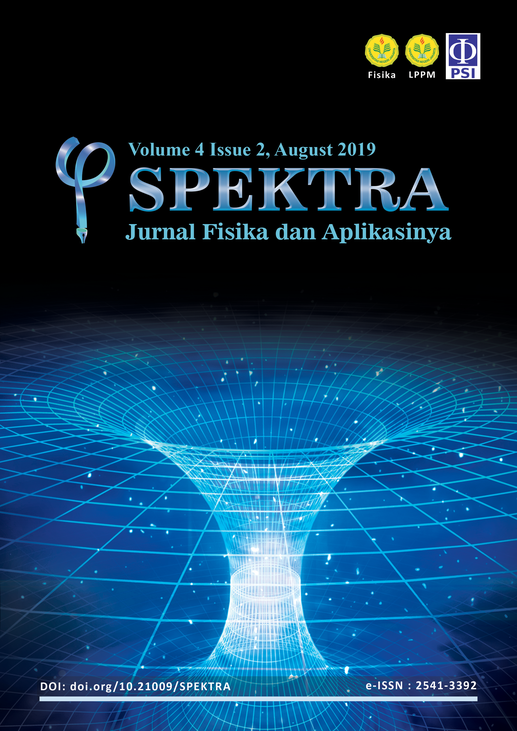FRUIT SWEETNESS CHARACTERIZATION USING IMPEDANCE SPECTROSCOPY METHOD
DOI:
https://doi.org/10.21009/SPEKTRA.042.04Keywords:
fruit, impedance, molecule, spectroscopy, sweetnessAbstract
The processing of agricultural products requires technology implementation to increase its production. One way of this technology implementation to increase the production is fruit sweetness measurement, which can be used as a sorting tool of fruit products. The sorting process using this tool can be done with easier way compare than the manual and destructive test. The fruit sweetness is composed of a mixture of sweet molecules fructose, glucose, and sucrose. The measurements of these molecules are usually done with four-point probe and use dc current. In this study, a fruit sweetness characterization using impedance spectroscopy method has been developed and realized, which uses an ac current. By using this method, fruit sweetness level can be characterized based on the impedance measurement on the flesh of a test fruit based on its dielectric properties. The obtained characterization results show that the fruit sweetness level can be measured by the impedance measurement. The obtained impedance is proportional to the concentration of the sweet molecule glucose. This method can characterize the fruit sweetness well and agrees with the calibration result. Therefore, this method can be used to increase agricultural products.
References
[2] K. Ku, H. Kim, M. Jeong, “Relationship between quality characteristics and skin color of 'Fuji' Apples (Malus domestica Borkh.),” Journal of Food Measurement and Characterization Vol. 13 No. 3, pp 1935-1946, 2019.
[3] A. Genizi and E. Cohen, “The chemical composition and sensory flavour qual-ity of ‘Mineola’ tangerines. II. Relationship between composition and sensoryproperties,” J. Horticult. Sci. 63, pp. 179-82, 1988.
[4] R.L. Shewfelt, “Measuring quality and maturity. In: Florkowski, W.J., Shewfelt,R.L., Brueckner, B., Prussia, S.E. (Eds.),” Postharvest Handling: A SystemApproach., second ed. Academic Press, Elsevier, Amsterdam, Netherlands, pp. 461-81, 2009.
[5] M. Charles, E. Aprea, F. Gasperi, “Factors Influencing Sweet Taste in Apple,” In: Mérillon JM., Ramawat K. (eds) Bioactive Molecules in Food. Reference Series in Phytochemistry. Springer, Cham, 2018.
[6] S. M. Lembe, L.O. Umezuruike, “Analytical methods for determination of sugars and sweetness of horticultural products - A review,” Scientia Horticulturae 184, 179-192, 2015.
[7] C. Ma, Z. Sun, et al., “Simultaneous separation and determination of fructose, sorbitol, glucose and sucrose in fruits by HPLC–ELSD,” Food Chem., vol. 145, pp. 784-8, 2014.
[8] K. Downes and L. A. Terry, “A new acetonitirle-free mobile phase for LC-ELSD quantification of fructooligosaccharides in onion (Allium cepa L.),” Talanta, vol. 82, pp. 118-24, 2010.
[9] K. Cools, et al., “Ethyleneand 1-MCP differentially regulate gene expression during onion (Allium cepa L.) sprout suppression,” Plant Physiol, vol. 156, pp. 1639-52, 2011.
[10] H. P. Schwan, “Electrode polarization impedance and measurements in biological materials,” Annals of the New York Academy of Sciences, vol. 148, no. 1, pp. 191–209, 1968.
[11] G. Yoon, “Dielectric properties of glucose in bulk aqueous solutions: Influence of electrode polarization and modeling,” Biosensors and Bioelectronics, vol. 26, no. 5, pp. 2347-53, 2011.
[12] P. B. Ishai, et al., “Electrode polarization in dielectric measurements: A review,” Measurement Science and Technology, vol. 24, no. 10, pp. 102001, 2013.
[13] H. P. Schwan, “Electrode polarization impedance and measurements in biological materials,” Annals of the New York Academy of Sciences, vol. 148, no. 1, pp. 191–209, 1968.
[14] R. N. Setiadi and M. Schilling, “Inductance analyzer based on auto-balanced circuit for precision measurement of fluxgate impedance,” Meas. Sci. Technol, vol. 29 (5), pp. 055007, 2018.
[15] E. Vozáry, P. Benkő, “Non-destructive determination of impedance spectrum of fruit flesh under the skin,” Journal of Physics: Conference Series 224, 012142, 2010.
[16] D. K. Kamat, D. Bagul, P. M. Patil, “Blood Glucose Measurement Using Bioimpedance Technique,” Advances in Electronics, 2014.
[17] J. Juansah, W. Yulianti, “Studies on Electrical behavior of Glucose using Impedance Spectroscopy,” IOP Conference Series: Earth and Environmental Science 31, 012039, 2016.
[18] E.D. Pershina, V.E. Burda, K.A. Kazdobin, et al., “Identification of the sugars content in the production of champagne by the electrochemical impedance spectroscopy method,” Surf. Engin. Appl.Electrochem. 49(4), 348-354, 2013.
Downloads
Published
How to Cite
Issue
Section
License
SPEKTRA: Jurnal Fisika dan Aplikasinya allow the author(s) to hold the copyright without restrictions and allow the author(s) to retain publishing rights without restrictions. SPEKTRA: Jurnal Fisika dan Aplikasinya CC-BY or an equivalent license as the optimal license for the publication, distribution, use, and reuse of scholarly work. In developing strategy and setting priorities, SPEKTRA: Jurnal Fisika dan Aplikasinya recognize that free access is better than priced access, libre access is better than free access, and libre under CC-BY or the equivalent is better than libre under more restrictive open licenses. We should achieve what we can when we can. We should not delay achieving free in order to achieve libre, and we should not stop with free when we can achieve libre.
 SPEKTRA: Jurnal Fisika dan Aplikasinya is licensed under a Creative Commons Attribution 4.0 International License.
SPEKTRA: Jurnal Fisika dan Aplikasinya is licensed under a Creative Commons Attribution 4.0 International License.
You are free to:
Share - copy and redistribute the material in any medium or format
Adapt - remix, transform, and build upon the material for any purpose, even commercially.
The licensor cannot revoke these freedoms as long as you follow the license terms.

 E-ISSN 2541-3392
E-ISSN 2541-3392  Focus & Scope
Focus & Scope  Editorial Team
Editorial Team  Reviewer Team
Reviewer Team  Author Guidelines
Author Guidelines  Article Template
Article Template  Author Fee
Author Fee  Publication Ethics
Publication Ethics  Plagiarism Policy
Plagiarism Policy  Open Access Policy
Open Access Policy  Peer Review Process
Peer Review Process  Retraction & Correction
Retraction & Correction  Licensing & Copyright
Licensing & Copyright  Archiving & Repository
Archiving & Repository  Contact
Contact  Mendeley
Mendeley 

